The Dragon

General Information;
One of the most populous species in the Realms' plethora, dragons are a unique species of powerful reptile, split into a variety of breeds and subspecies. They have little in the way of defining, strict characteristics, and abilities range across the board. Dragons are the most powerful race found in the Realms, created in the shapes of their reigning Greater Gods.
A variety of offshoot species related to dragons exist, including the tca'ier dragons, Yorijian dragon, and Circadian dragons.
Statistics;
Name:: Dragon
Average Lifespan:: Immortal
Average Height::N/A; depends on variant
Average Weight::N/A; depends on variant
Location Found:: Abroad.
*all statistics based on averages; extremes in any direction, or found in odd locations, are always allowed.
Notes;
Conformity Dragons are immensely varied in appearance, body type, and overall design. The variants you see here (not including the subspecies, which have their own unique traits and features, their info at the bottom of the page) are basic guidelines. Nearly any variant may have almost any appearance, as long as it fits these guidelines. Those that do not fall in any one category can often be classified as a hybrid between types. However, most often, a dragon is sorted by limb count alone: thus, one with four legs and two wings is a western, one with two wings and two legs is a wyvern, one with four legs and no wings is a drake, etc.
Birth vs Hatching Dragons may either lay eggs or give live birth depending on the individual and their particular family; more reptilian dragons will lay eggs, while more mammalian will birth live young. In cases where dragons of both kinds interbreed, what the mother is closest to will decide how the young are born. Very rarely, these will be switched - where reptilian dragons with mammalian heritage will rear live dragonets, or where mammalian beasts will lay hatchable eggs.
Dragonriders Unique among species, dragons are able to form strong platonic mental bonds with other races not of their own kind. While some dragons may live their entire lives without meeting such an individual to bond with, it may happen at any time in a dragon's life from hatching to their ancient years. These bonded individuals are called 'dragonriders', and may be of any species or race, though humanoids are most common.
Dragonrider bonds may form in a variety of ways, and in various timeframes. Bonds may be forged out of endured hardship together, great emotional stress, a long-standing and strong friendship, and any other number of reasons. However, it must be mutual, and cannot be shallow. When a dragon and rider bond their minds are connected intricately to the point where one may know the other's thoughts and experiences, feel their pain, and share their emotions.
Should a dragon or rider die and their partner survive, depending on the strength of the bond, the partner may suffer extreme pain, break mentally, or die. Thus, when a dragon or rider has the chance if they realize there is no way to save themselves, it is customary to sever ties before it is too late. This still causes pain, but it won't take the other's life.
Easterns - Hybrids Eastern dragons from different regions do interbreed with one another, and hybrids between the types are common in areas where the paths of various clans cross. In this, Famine-region dragons often have the most interest from other easterns, where War-region dragons often have the least. These hybrids often dwell with the dragons they resemble most: IE, a dragon who looks more Pestilence than Famine will live with its Pestilence family instead of the Famine clans.
Multiple Heads Hydras are not the only dragons who have multiple heads. Those of any type may be born with two or more heads, and differ from hydras in many ways; primarily, those born with two or more heads that are not hydras have a fused spirit and split personality, though this is not always the case. Some may be born with a single spirit, much like hydras.
Dragons with multiple heads are often due to conjoined twins, magical or mechanical tampering with the egg or young before they are born, and a variety of other factors. These multiple-headed creatures may be completely healthy, or have various health defects; likewise, they can have separate personalities per head or have a single entity, depending on the individual. Most consider dragons with multiple heads that are not hydras to be touched by Kazule, even if many die early on from health complications.
Name - Easterns The reason that these dragons are called 'easterns' is because the breed originated in the demonic Realm of Kurai, trapped there before and during the Bloodreign War. They populated the eastern region of the Demon Realm for hundreds of years before spreading to other Kingdoms, and some thousands before they were able to return to the Realms at large. To this day, they are known as 'easterns' for this reason.
Name - Westerns Dragons with four legs and a pair of wings are widely referred to as 'western dragons' or 'westerns'. This came about after the destruction of the First Realm, when they were sent to Millirand to save their race from extinction. Initially, they settled in the eastern parts of the world, and went on a great western migration witnessed by humans, elves, and dwarves. The humanoid nations they came to settle in referred to them as 'westerns', and the name persisted long after they settled across the Realm, even after spreading to other, unrelated worlds. The usage of the name continues even today.
Subculture; Halgian The Evylonian subspecies of dragons that dwell in the Halgian Empire, primarily Golds and Silvers, revere Daama just as strongly as the Halgians themselves do, and are in general more militant than the dragons in the rest of Evylon. A proportionately high number of them will take a rider at some point in their lives, and they serve the Empire faithfully. While many of them maintain mostly friendly rivalries with other dragons, they are highly loyal to one another. The Blacks of Umbra are very similar, aside from being loyal friends and allies to the Fallen.
Subculture; Heartwoodian The Evylonian subspecies of dragons in Shi'vrann'aeli are, as a whole, stalwart friends and allies to the elves. However, despite this friendship, the dragons generally prefer to live in the wilds, surviving on their own and ensuring the more violent-natured dragons are kept away from elven territory. Despite living largely solitary lives, they tend to stay in touch with one another, and may form small family groups to raise young. These dragons can be found anywhere from the Heartwoodian Forest itself to the Blackdrake Range and beyond.
Subculture; Driakkion The Evylonian subspecies of dragons in Driakkion are proud and fiercely independent, loyal to their clans more-so than to Driakkion as a whole. However, while the clans commonly quarrel with one another, they are swift to unite against any outside threats. They alone still hold to honoring the Old Gods, refusing to treat Daama as a deity unlike Heartwood and the Halgian Empire, though even the oldest among them have forgotten the names of said gods. They are highly intolerant of non-dragons so much as visiting Driakkion, let alone settling there, though they make rare exceptions for those few who have earned their respect, or request to visit in an official capacity.
Variant Hybrids All dragon variants may interbreed and create viable offspring regardless if these are hatched or born. However, there exist no terms to refer to these oddball mixes, though many do exist. They are still referred to by their limb count in most cases. For example, if an eastern and a western were to breed, creating a maned, long-bodied, winged hatchling with four short legs, this would still be considered a western. Should a wyvern and knucker procreate and render a dragonet with hind legs, no forelegs, and flightless, vestigial wings it would still be considered a wyvern. This continues for most, if not all, possible variations due to hybridization between the variants.
Interbreeding also exists between the various subspecies and the regular dragon variants. However, these hybrids may also be referred to as half of whatever subspecies they have heritage from; so as an example, a Cosmic dragon who bred with a wyvern might render a hatchling that could be simply considered a half-Cosmic wyvern. Likewise, half-Desert Gold, Heartwoodian, Gemdrake, etc all may be referred to in similar ways.
Lunar, Solar and Celestials Once long ago, there existed many dragons with celestial alignments; those who called their power from the sun, moon and stars. Very few are left now, so few that they were once thought to be extinct.
Diet This is what this species, and any variants, may eat at any given time.
Common:
Majority-
primarily red meat; sometimes fish; large plantlife; varies greatly per individual.
Cavewyrms-
small game living underground; sometimes mushrooms.
Easterns-
lesser, non-sapient demons; red and white meat. generally large game.
Sea Serpents-
large fish, up to and including whales and ophidians.
Uncommon:
Majority-
white meat; small game. sometimes nuts and berries.
Cavewyrms-
roots and moss.
Easterns-
Kuraian fish; other Demonic food, such as bloodrice.
Sea Serpents-
crustaceans.
Rare:
Majority-
carrion; bone marrow. dried and dead flora.
Cavewyrms-
carrion; fungi; sometimes insects.
Easterns-
carrion; sapient creatures.
Sea Serpents-
carrion; seagrass and other underwater plantlife.
Overview:
Dragons are immensely varied in their diets. While the greater majority of dragonkind are apex predators, they also partake in a vast array of different foods. Most hunt with regularity, with smaller dragons hunting more frequently than larger beasts. Others may forage or fish, and some grow their own food or raise their own livestock. However, it is rare that any dragon would partake in something already dead, and most do not hunt sapient prey. Easterns are the most common in hunting unusual living prey, while cavewyrms are able to devour things other variants may think completely inedible, such as roots and fungi.
Of the draconic subspecies, very few deviate from the full species' diet. Arbordrakes feed specifically on berries, fruit, and insects without taking down live red-meat prey. Gemdrakes - while they do eat traditional prey - devour gemstones of various kinds to facilitate the growth of jewels in their scales. Gurthadrakes do not need to feed at all.
Most of the Evylonian breeds have diets that are very similar to the variants they most resemble, though there are a few differences. For example, Heartwoodian Whites live on a semi-strict diet of fish, owing to the unique shape of their snouts and teeth.
Gallery;;
Returning soon!
Credits;
Species info credited to Verridith, Fyfergrund, Skye Hajime, Lypten, Concinnity, Soundthebugle, and Entity.
In-Depth Information;
Appearance Dragons are one of the most well known creatures in all the Realms. However, dragonkind varies incredibly greatly by variant, as well as within those variants themselves - it may be difficult to tell apart the different types, even those of the same basic build. Among the races, dragons are perhaps the most diverse, and are considered to have been made in the shape of the greater gods themselves. Below you will find the basic appearances of all dragon variants, as well as image guides* for convenience.
Remember that all actual images in the variants are only examples of limb count and very basic body type, and do not reflect the exact image of the breed itself.
In most - if not all - of these variants, dragons may have any basic appearance so long as they match the variant details. Dragons may be found with scales, fur, feathers, hide, skin, or a combination of any of those traits. Colors and markings are limitless, as are mutations (such as extra eyes, extra wings, split tails, unusual horns or spines, or any other assortment of odd features one can think of). Common features may be listed per type, but all are generalities and only limb count and position are the deciding factor on what variant a dragon may be.

Amphithere
Dragons without limbs - fore or hind - that have one or more pair of wings are referred to as amphitheres. These wings are almost always flightworthy, and are generally attached to the dragon's ribcage or slightly behind it. Multiple wings, such as those located where the hind legs would go or along the tail, are also common. Flightless amphitheres (those born without flight-capable wings - vestigial or simply too small to sustain flight) are rare, but not unheard of. These wings can be of any type and appearance, size, or shape.

Cavewyrm
The wyrm, or cavewyrm as it is better known, is a type of dragon that has no limbs or wings whatsoever. It is serpentine in shape, built like a large snake, and may appear much like one at first glance. However, most cavewyrms can be told apart by not only their great size, but also various differences from true snakes and snakekind that may include (but are not limited to): frills, horns, spines, feathers, colors, markings, and an assortment of other appearances that snakes cannot have.

Drake; Groundrake
The groundrake is a wingless, quadrupedal dragon, often simply called a 'drake' for short, though this may get confused with both its cousin variant the runnerdrake, and the alternate term for the species. Groundrakes may be found in any shape, size, and build, though there exist two somewhat distinct types: one being slender and lithe, often found in wide open areas, and the other bulky and strong, better suited to life in mountain ranges or underground. Both of these types may be found with a variety of appearances, traits, and mutations.

Drake; Runnerdrake
The runnerdrake is a wingless, bipedal dragon, often simply called a 'drake' for short, though this may get confused with both its cousin variant the groundrake, and the alternate term for the species. Most often, runnerdrakes are built much like saurian raptors and sport arms instead of forelegs, along with powerful hind legs for speed. They can be found with a variety of appearances, traits, and mutations.

Eastern
The eastern dragon is a long, serpentine creature with short legs and no wings, originating through magic-tainted evolution in the Realm of Kurai. They commonly have manes and whiskers, though otherwise vary greatly in appearance depending on both the individual, and region of Kurai in which they come from. Those eastern dragons originating from Noshinka are large, averaging around fifteen feet at the shoulder, with a vast range of colors and physical features; they have five clawed toes on each forepaw. Those that originate in northern Kidochi are of middling size, and can be found with thick fur and feathers more commonly than others; they have four clawed toes on their forepaws. Those that originate in Shinigami are medium to small in size, have shorter bodies and heavier builds; they have three clawed toes on each forepaw. Those that originate in Isekikuni are the smallest of easterns in size, with subdued features and colors; they have two clawed toes on their forepaws, though some may be born with an additional thumb.

Hexadragon
The hexadragon (or hexadrake depending on whether or not one has wings) is a large dragon variant with six legs. Believed to be the collective result of years of mutation and breeding, these still-uncommon dragons may now be found in many different Realms. While hexadragons - those with wings - often resemble westerns at a glance, they always have either an extra pair of forelegs or hindlegs depending on the individual. Hexadrakes are similar, but have no wings. The shape, size, and location of the extra pair of limbs varies by individual, and colors, markings, and other features range as widely as their varied kin.

Hydra
The hydra is a large type of four-legged dragon that can stand either quadrupedally or bipedally, and may have wings or not; however, they always have three or more heads compared to similar breeds. The more heads a hydra has, the less intelligent it is known to be, and thus one may decide how safe an interaction with these beasts may turn out from a distance. Hydras are much larger than many average dragons, but sport duller colors and less extravagant features. While they may have fur, feathers, scales, extra horns, and any other things other dragons may have, these are less grand, duller, and blunter in overall appearance.

Knucker
The knucker, or serpynt, is a long, snakelike, semiaquatic dragon with short legs and flightless, vestigial wings. They tend to lack great ornamentation, though they may come with any variety of colors and can be found with hide, scales, or (rarely) feathers and fur. Most do not even have horns or any sort of spines, though they do sport webbed claws and sharp teeth. Some may be found with gills and webbed talons, but not all.

Lindwyrm
The lindwyrm, or lindworm, is a long, serpentine dragon with no wings and only one set of legs, either forelegs or (rarely) hind legs. Most have immensely long tails, much like a snake, with a pronounced chest where their forelegs attach. Those born with hind legs often have much shorter bodies with less pronounced chests, stiffer and shorter tails, and may seem proportionally awkward. Lindwyrms may come in any color with any markings, and often sport extravagant colors and features.
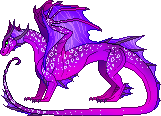
Ouroboros
The ouroboros is a dragon much like the knucker; they are semi-aquatic with long bodies and tails twice that length. Some may have small, vestigial wings while others do not, and most have some sort of webbed frills as well as webbing between their toes. Most unique about the ouroboros is that they never have ornamentation on the ends of their tails - instead, these are knobbly and notched, perhaps due to their habit of holding their tails while they sleep from hatching into adulthood. They may be found in any color, with any markings - though most do not sport feathers or fur.
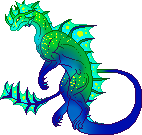
Sea-Serpent
The sea-serpent is a fully aquatic dragon that dwells the majority of its life under the ocean. They are generally long-bodied, and have a variety of frills, webbing, and gills. Some may have fins or wings to propel them beneath the waves, though these are rarer; others may be born without legs, or with only one pair. They most commonly sport colors of blues, greens, and purples, though others have been noted and marking hue and variety range across the board.

Western
By far the most commonly referred to when one references the species, western dragons have four legs and a pair of wings in any configuration. These wings are almost always flightworthy, though smaller, vestigial versions (usually inherited from knucker or ouroboros heritage, though may be caused by mutation, developmental issues, or injury as well) may also be found. Western dragons may have any colors, any markings, and can often be found with any mix of traits depending on the individual: fur, feathers, scales, hide, skin, plates, extra wings, extra eyes, nearly anything is possible.
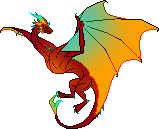
Wyvern
The wyvern is a dragon with a pair of wings and one pair of legs in any configuration. They may be found with builds resembling raptors, bats, or may have a shape much like the serpentine lindwyrm depending on their wing shape and where their limbs may be found. They may have any colors, and can have scales, hide, fur, feathers, and any number of varying traits.
Culture Dragons are one of the Realms' largest populations, and may be found in some number in almost any world. Many of these areas gain a population of many different variants, from westerns to cavewyrms and everything in-between. These dragons are found in countless occupations in various Realms, though these may differ from region to region. The largest draconic populations per region are listed below.
Felnovian/Vystrian: The dragons of Felnova - primarily the country of Vystriana - are a proud race, delighting in their strength and power. For many of them, especially the ones prone to dwelling in cities, becoming knights in the service of the reigning monarch of Vystriana is the highest honor they can achieve, as well as viewing it as their duty to put their power to use in defense of the Crown, and the many peoples and races they watch over.
These dragons do not mind the company of non-dragon species, and will actively dwell, work with, trade with, etc those from all walks of life. Most of them tend to be strongly devoted to the Felnovan Five moreso than any other gods. Those dragons who prefer to dwell in the wilds tend to be somewhat reclusive, and are more apt than their city-dwelling cousins to gather hoards of treasures.
Kuraian: The dragons of Kurai, the distinct easterns, are a proud and aloof race, dwelling in hidden settlements far from demon eyes, save for those who dwell on Proudscale Peak located deep within Famine territory. The dragons of Famine tend to be the most culturally developed, and boast a sizeable number of scholars and crafters, followed by the dragons of Pestilence, who are more reclusive than those of Famine. Death and War dragons are more reclusive still, especially those of War, who are highly elusive, even towards other dragons. While the Famine dragons of Proudscale Peak tend to view the others as practical barbarians, they do allow them to dwell at the Peak, for safety or learning.
Millirandian/Remnant: The dragons of Millirand, especially those who are strongly associated with the Remnant, tend towards dour melancholy as they cling to the past and mourn what they lost. This has led them to develop various rituals and practices devoted to preserving the past. While they still tend to hold to honoring the Ten, especially the Millirand Five, their faith is considerably weaker than the devotion their Vystrian cousins hold for the Felnovan Five. For some of the Millirand dragons, especially the younger ones, holding so hard to lost glories is a futile waste of time. These individuals tend to hold themselves apart from most of the Remnant, and seek to make the most of their lives.
Noctisian: The dragons of Noctis tend to be much more reclusive and secretive than dragons found elsewhere, save for those few who have taken to dwelling alongside the rest of Noctis's people. While those who live in Vista can be relied upon to answer a call to serve Gilfelza, though under their own terms, the dragons of Tinda-Lau hold themselves separate from all outsiders. They do nothing to dispel the various rumors and mysterious aura that has built up around them.
Some of the variants do not find themselves adhering to the above regions, and these smaller populations have their own cultural tendencies generally differing via type. Information on these may be found below.
Amphithere: Amphitheres that hold themselves apart from regional populations often dwell in small, traveling clans that wander the worlds at will. However, a sizable portion of their number still dwells in Lizzarkyth, where they evolved in the deep jungles, though these tend to stay far from civilization at large.
Cavewyrm: Cavewyrms that hold themselves apart from regional populations live primarily underground alongside dark elves and dwarves, though they enjoy the former over the latter. While they share close bonds with those of other races, most cavewyrms are more solitary than other variants, coming together only to find mates and rear families.
Drake; Groundrake: Groundrakes that hold themselves apart from regional populations can be found both aboveground and underground, in multiple Realms. They enjoy hardier races such as sol'tera ad dwarves, and often find themselves as miners, craftsmakers, and smiths. Some even aid other, weaker races as sapient beasts of burden - though referring to one as such is very ill advised.
Drake; Runnerdrake: Runnerdrakes that hold themselves apart from regional populations enjoy living in small clans or packs, and can be most often found in wide-open areas. These packs do not mind the company of other species, and are quite quick to offer aid to those in need. They love to challenge quick species to races, tournaments, and hunts of all kinds.
Eastern: Eastern dragons that are not found in Kurai often integrate fully with other dragon variants in various Realms. Vast populations of them do not exist in any great number outside of Kurai, however; thus, further cultural details may be found in the Kuraian section located above.
Hexadragon: Hexadragons that hold themselves apart from regional populations are very common, as many do not fit in well with regional cultures. Thus, hexadragons form medium-sized clans of their own variant and can be found primarily in forests, mountains, and other little-touched areas where they will not be bothered.
Hydra: Hydras that hold themselves apart from regional populations are known to be solitary, and do not often interact with others - especially if they have a great number of heads. Otherwise, little is known about hydras who form anything more than small family groups, if that.
Knucker: Knuckers that hold themselves apart from regional populations are mostly solitary, though may form small groups and families depending on the individuals in question. Most dwell in swamplands, bogs, and various other semi-aquatic areas.
Lindwyrm: Lindwyrms that hold themselves apart from regional populations detest the company of other dragon races, instead choosing to dwell either alone or with those that they may bond with over similar circumstances. They often can be found in hidden-away drow cities, where other dragons are not present.
Ouroboros: Ouroborai that hold themselves apart from regional populations are almost fully aquatic, and live in pods or extended family groups in oceans, rivers, and large lakes. They dwell alongside and with Yorijian dragons and sea-serpents, and may even interbreed with them on occasion. Ouroborai are unique in that their prehensile tails play a great part in their lives - they are known for sleeping with the ends of their tails in their mouths, and often use them to utilize tools of many kinds. Insulting an ouroboros' tail is a grave insult, and may ignite the ire of an entire pod.
Sea-Serpent: Sea-serpents that hold themselves apart from regional populations are fully aquatic, and often live alongside other underwater races. They may form small kingdoms and/or cities beneath the waves for themselves, far from any shores.
Western: Western dragons are so widespread, and found in so many different places, that large non-subspecies populations of them tend to take after regional cultures as many they have forged themselves. Those that do not are often solitary, living in the wilderness in small family groups.
Wyvern: Wyverns that hold themselves apart from regional populations can be found in small clans, primarily in mountainous regions, canyons, and cliffsides. Some may wander in solitude, but most wyverns dwell in regional cultures more than their own far-away groups.
Abilities Of the sapient races, dragons have quite possibly the most diverse and expansive range of magical potential of any sapient race. Most dragon types may be born with magic, and the range and power of abilities - both elemental and not - vary by individual. Many dragons have control over one or more elements, and non-elemental magic of any kind is likewise common. For a dragon to be born without magic completely is unusual, but cannot be called altogether rare. Dragons, depending on their size and type, may also be very physically strong and fast, though this varies from individual to individual and takes into account their age, skill, and health just as much as their build and variant. Due to their versatility, these creatures are considered some of the most powerful in the Realms, created in the image of their gods.
Many dragons have the ability to generate breath-weapons of some degree, elemental or non, and either magical, biological, or a mixture of both. The most common occurrence of breath-weapons has been the ability to breathe fire, which has left a mark on multiple legends and tales. However, dragons are not restricted to fire, or having breath-weapons at all - many do not.
The dragon variants all have their own common unique attributes, as well; some are magical, while others are physical. These are listed below.
Amphithere: Most amphitheres have incredible stamina, and are able to sustain flight for long periods of time. Those that take to water instead of air are able to hold their breath for long periods of time due to a larger, stronger set of lungs.
Cavewyrm: Many cavewyrms have the unique ability to see in complete darkness, and are able to sense what is underground with uncanny accuracy. This can be anything from subterranean creatures to bad air. Many cavewyrms also have an affinity for the earth element, which aids in tunneling deep underground.
Drakes: Both groundrakes and runnerdrakes have great stamina and speed. Runnerdrakes are superior sprinters, while their quadrupedal counterparts excel at long distances. Many are able to better process energy consumption during physical exertion, and this is widely thought to contribute to their speed and strength overland.
Eastern: Eastern dragons of all four types have the ability to fly without wings. This form of flight, much akin to levitation, requires very little energy to use and comes as naturally to an eastern dragon as swimming does to a sea-serpent. Those born without this innate ability are often considered cursed or mutated beyond redemption. Otherwise, eastern dragons tend to be very strong magically, and are impervious to Kurai's mild acid rain.
Hexadragon: Despite the extra, sometimes ungainly third pair of legs, hexadragons have adapted with greater motor control than others; they learn to walk, run and fly much faster than dragonets around the same age. Because of this, hexadragons are often skilled at crafts and intricate magics that require precise movements, glyphs, or signs.
Hydra: Hydras are generally quite large and fast-growing among the dragon types. They are very physically strong, but are not fast; and most do not have magic at all. Those that do tend to have differing magic per head, or other such unusual abilities. Very rarely, these abilities grow to be immensely strong - but this may adversely affect a hydra physically, and take a toll on their bodies as they age. Thus, most magically-adept hydras do not live long enough to reproduce as frequently as others of their kind.
Knucker: Knuckers are primarily amphibious semi-aquatic dragons with the ability to hold their breath for immensely long periods of time. Many are able to submerge themselves in water for several hours, and may dig themselves into mud for concealment for many more. Most knuckers are also nearly impervious to acid, poison, and venom of multiple types, though they are one of the weakest variants magically.
Lindwyrm: Lindwyrms are powerful magically, though quite weak physically. They are able to sea in the dark and navigate over (and under) terrain larger dragons cannot, due to their much smaller average size. They are also able to go long periods without eating, and their origin in Evylon has given them more magical resistance than other variants like them.
Ouroboros: Most ouroboroi are semi-aquatic bordering on fully aquatic dragons with the ability to breathe underwater as their sea-serpent ancestors do. Most live their entire lives beneath the waves, and have developed a keen sense of sight - both visually and with tools such as echolocation and aura magic - to deal with the darkest depths of the sea.
Sea-Serpent: All sea-serpents have the innate ability to breathe underwater, whether their gills are visible or not. Many of them learn to swim immediately upon hatching or birth, and most have some affinity for the element of water.
Western: Western dragons do not have any one innate trait unique to them; they are the most varied of the dragon types, and can be found with nearly any type of ability or magic known in the Realms today. However, western dragons are considered the strongest of the variants for this reason, even if they do not have any particular one magic to themselves. Despite this, westerns without any magical affinity are known to exist even if their parents were magically adept.
Wyvern: Many wyverns are opposite on the power scale than their western cousins - their magic is rarely as great as a western's, though they have elements more commonly than the other types. Almost all wyverns have some sort of breath weapon, elemental or no.
Species Origin;

Once, there was nothing; a nothing so deep and vast that little could pierce it. When the One created the first spark of light, and crafted the first few beings to live in the doomed World, it is said that he crafted them from light itself in the form of odd creatures very unlike what exists today.
However, when the World fell to the lack of balance and the First Realm was born, the first races were nothing like what we know now. They erupted in war, and the One felt the need to stop it; thus, he crafted the first of the Known Races in his own shape. A species to rise and rule the warring peoples, to stop the bloodshed and end all war. The dragon.
The first dragon's heart was crafted of fire and light; the One took wind and bound it into wings, molded stone into strong muscles and capable limbs. The tail and neck was spun from water, claws and horns fashioned of ice. Lightning granted great beauty, and darkness an inescapable power.
In this chaotic form, the One carved protective scales, and planted in them all the colors of the world. The Void hydress, smiling at the One's creation, gave the first drake her own gift - and a true name. Kazule, King of Dragons, felt life curl within him as a single head and tail split into five, and power radiated from him stronger than the force of all the elements combined. The earth trembled beneath his claws; fire greater than a thousand infernos burned within him. The wind howled at his command as a tornado, and rain crashed down around him when he willed. Lightning sparked with great booms of thunder when he spoke, and ice frosted everything he touched.
You will be the one to lead all that follow, the One rumbled, as the new-made dragon looked around in wonder at the beautiful world that it had been born into. You are Royal, a King. You hold the blood of those much more powerful than others; your race will be supreme, shaped in My image, and you will rule as I have intended. Go forth and let the blessings of the One and the Void go with you, King Kazule, First of Dragons.
As Kazule learned how to control his powers and explored his new Realm, the One crafted other, lesser dragons to follow him; those with four legs and a pair of wings, a single head and jewel-bright scales. Over time, through the First Realm and into the Living Realms we know today, many other dragons were to follow. All are still ruled by the royal bloodline of Kazule, the first of dragons, though none from the First Era live now today.
The First Dragon was the first of all royals, an Ether of the Light Realm, and King of Millirand for many years. Kazule Silentscale was his name, known for an uncanny ability to fly and move with absolute silence, even considering his usually-gargantuan size. He was the most powerful of dragons, and had the ability to split his consciousness and body into five separate drakes, much like the One and Death.
In his normal form, Kazule was a massive five-headed dragon with iridescent, rainbow-hued scales that shifted and changed color with movement. His central head sported golden scales and six facial horns, topped with large, curved horns that were metallic silver in color; his eyes were a deep, dark violet. The head to his right held blue scales and purple frills, with scarlet eyes. The head to his far right was onyx in scale color, with dark gray, ram-shaped horns and silvery eyes. To his immediate left, a head with scarlet scales and sky blue eyes rose, with long black spines. To the far left, a head with scales white as snow, silver fur and blazing golden eyes. He had large wings with white webbing that shaded to silver, and long tail-frills that helped support him in flight. Each neck's various spines, horns and plates turned to black feathers sent trailing behind him as he moved, and his tail held a silver spade at its end.
Each form he could split into corresponded to one of the heads, each named differently as a play off of his true name, Kazule. From right to left, there was Lazul, Bazul, Kazul, Tazul, and Fazul. Lazul was a slender black dragon with sharp, angular features, and control over darkness and lightning. Bazul was a large blue dragon with multiple frills and wide wings; he had control over water and ice. Kazul was a graceful gold dragon with silver horns, and had control over fire and light. Tazul was a bulky red dragon with control over earth and heat. Fazul was a delicate white dragon with powers over ice and wind.
Long did Kazule rule over Jes're'en and all of Millirand, after coming from the First Realm; he won many wars, and set in motion events that still echo thousands upon thousands of years later. He met his end at the fangs of Snayc, in an ambush that took the First Royal's life.
Subspecies;
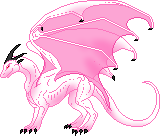
Albino
Classification: western or wyvern. Location: widespread.
The Albino, or Blackbone, dragons are a unique subspecies rather than just a color variant - though true, non-subspecies albinos may be found in any of the dragon variants. The individuals in this subspecies are normally western in build, although wyvern types have been noted (albeit uncommonly). Though their body types vary, they are always pale white or cream with pink tints where the scales, fur or feathers run thin, showing their pigmentless skin. Some may have manes, feather crests, or frills but their coloration in all is always white, rarely translucent and clear. In sharp contrast to their flesh their horns, claws, and bones are black along with any spines or spikes they may possess. Pale markings may be very faintly seen on their bodies but most albinos are solid colored without much to break up their hides. Aside from their characteristic white scales and black bones, they are highly variable in form.
Nearly all, if not the entirety, of the species has a connection to the Sight. They often see visions of the future and sometimes the past, not always willingly. Their ability to control these visions vary greatly from individual to individual and may cause some of them to go insane if their abilities grow beyond their control. They appear to have an increased aptitude for magic for unknown reasons, possibly due to the speculated magical quality of their black bones. As such the black bones, horns, and claws of albino dragons are revered for their properties in spells and enchantments alike and are considered highly valuable.
Many Blackbone dragons live with other dragons quite easily, and may form families within any community of drakes imaginable. Those that do may produce offspring that may display a mix of their Blackbone traits and racial albinism, though the bones themselves may not be entirely black. Some may be speckled or mottled, and none of these hybrid hatchlings have the magical qualities of their parent. However, many Albinos see this as a dilution of their race, and tend to dwell in communities where their black-boned lineages breed true.

Arbordrakes
Classification: tiny winged dragons. Location: forested areas; otherwise abroad.
Arbordrakes are tiny dragons that never grow larger than a foot long, or a few inches tall at the shoulder. They are long in body with short legs, built delicately to traverse the tree branches of their forest homes. The majority are hexadragon (six-legged) in body type, while wyverns and westerns may also be found; all arbordrakes have large, flightworthy wings. Otherwise, they may come in any color, and have any mutations much like normal dragons. Scales, fur, feathers, hide, extra horns, extra wings - all are common. Metallic and glossy qualities are found very often, and once were used as a way to tell these dragons apart from the more common non-sapient fauna, the feylizard.
Most, if not all, arbordrakes have defensive magic more than offensive capability; most do not have any sort of breath weapon, and those that do are ostracized and exiled. Earth and nature abilities are extremely common, where light and water are similarly frequent. Fire and lightning are almost never found, and those born with these elements are seen as omens of destruction and doom.
While they are known to outsiders and non-dragons as arbordrakes or 'false feylizards', these creatures call themselves the 'abrindriakk', Dragonic for Tree Dragon(s). Names are something of importance to them; while abrindriakk is their preferred species title, calling one an 'arbordrake' is acceptable to them, where as if any are called a 'false feylizard' they will react in indignation and anger.
Most arbordrakes dwell in family groups or small cities built within the treetops of their forest homes. These dwellings are often too small for any normal race to enter, save for perhaps some fairies and imps, of which arbordrakes readily welcome into their communities. However, some of these false feylizards strike off on their own as loners, and can be found anywhere abroad. Others found alone and outside of forests may have been exiled, or otherwise driven away by their birth-clans.

Desert Gold
Classification: western.
Location: Exodus Desert, Vystriana.
Shaped by the extremes of the Exodus Desert, the Desert Golds of Vystriana are dragons like no other; they have become highly adapted to the desert they call home, down to the colors of their scales. Often, their hides are the colors of sand in a wide range of shades ranging from metallic golds and yellows to creamy tans and rich browns, though the latter are much more rare. Most of them have white manes running down the entirety of their backs from their brows to their tail. Nearly all have markings, be it bands, stripes, or spots, across their body in shades of white or pale cream, and some may display darker points along the feet and wings. They are always westerns and usually tend to be smaller dragons than elsewhere in Vystriana, though this is prone to exception.
Desert Golds have an uncanny ability to navigate the featureless sands, and have a sense of direction rivaled by few. They appear to be guided by some internal compass attuned to the intricacies of the desert, perhaps aided by the stars, moons, and suns of the Realm they find themselves in. This ability makes them invaluable to those wishing to cross it safely. Their scales are very resilient to all types of heat and their fires are some of the hottest in the known Realms, causing them to be sought out by those wishing to smith otherwise unusable material. Light is a close second in elemental affinities, leading many to be sought as healers to those near the great deserts in which they dwell. Strong abilities with wards, illusions, and barrier magic are also common in addition to their gift for fire and light. They cannot tolerate cold and are very vulnerable to the element of ice.
Few ever leave the desert of their homeland, but those that do can occasionally be found roaming the Realms - often to settle in faraway sands such as Arcadia in Ristell, and the Gorganoth Desert in Millirand. In the Exodus, most of the Desert Golds live in small clans or family groups, often nomadic and rarely staying in the same place for long. They do, however, return to center of the desert to lay their eggs and raise their young to flegelinghood, before setting to travel once again. Those that live in other Realms' deserts may form similar groups and live in similar ways; however, individual Desert Golds that choose to live away from the sands may fall in with whatever culture they find themselves within.

Gemdrake
Classification: any dragon type. Location: widespread.
Relatively small, unique dragons who's scales begin to hyper-mineralize as they grow older. Gems will begin to form inside of their scales, making them look veined in crystal, before the scales are overtaken completely. Usually, mineralization begins on the chest, back and head - then it grows to encompass the legs and tail, before touching every scale on the dragon's body. These dragons generally hatch with pale, almost pure white scales, which begin to take on the colors of whatever minerals they consume. Gemdrakes who abstain from consuming minerals may develop pearl-colored gem-scales. While they most commonly look like western dragons, variations can and do occur - any variant is possible, from the wyvern to the groundrake, though these are much rarer. Very old gemdrakes will look made entirely of living crystal, though this varies from individual to individual, and even young adults may display above-average mineralization before their time.
Gemdrakes shed their gem-scales once a year in the springtime, in which new scales will grow in their place. Mineralization in these new scales is very, very quick, and the gems may return within a week of the initial shedding. These shed scales are gemstones, usually of a variety of color, and can be used in a multitude of magical workings, or jewelry. Some gemdrakes collect their shed gemscales and travel to cities to sell or trade them for other items at a bazaar, and still others may craft them into a variety of things. Many gemdrakes are skilled in the working of gems, and are commonly gifted with enchanting and other non-elemental abilities. Elemental abilities are rarer, but still found.
Most gemdrakes tend to live on the outskirts of normal dragon society. They are rare, and their food sources relatively scarce - combined with the fact that some may hunt them for their gemscales regardless of a shed, many are happy staying out of the public eye.
Gemdrakes are limited store species; please do not make one unless bought. Thank you!
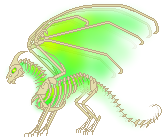
Gurtha Dragon
Classification: any. Location: abroad.
When a dragon dies in a particularly traumatic event or leaves some form of unfinished business behind, their soul may be unable to rest. These spirits may then become bound to their physical forms and rise afterwards as unique, spiritually bonded undead dragons who differ from their more traditional types quite significantly. While their body type varies depending on the variant or subspecies of dragon, all burn away whatever flesh remained with powerful reiatsu that then settled to burn within their skeletons, seen as a colorful conflagration within their ribbones, extending to fill the space between neck and tail bones beneath the spine. This reiatsu is also seen as a thin sheeting of energy spanning through the wing bones to form phantom web that has the ability to grant them magical flight. Its color corresponds to the color of their spirit in life, and does not often change.
The amount of reiatsu visible varies depends on the strength of the spirit itself and can be as large as their former bodies were or as little as a simple glow. No matter their strength, gurthadrake eyes always glow brightly, matching the color of the aura contained within. Their bones appear to be completely clean and devoid of any rotting flesh; these bones are commonly bleach-white, but may be mottled or black if they have risen from Albino hybrids or purebreds. Any damage to a skeleton - before or after death - is retained, though 'healed' breaks may glow with the energy that fuses them, as the bone does not actually regrow.
Individual abilities vary widely from gurtha to gurtha, although strength is normally tied to the bound spirit’s will to live. Most do not retain many, if any, of their former abilities. They are highly vulnerable to spiritual and energy based attacks as well as any physical attacks that cause damage to their skeleton. While they can use reiatsu based magic, their available reiatsu does not regenerate and once it is completely spent or eradicated they will be destroyed. This can be worked around - they may accept energy offered by another, siphoned from plants/animals around them, or through an enchanted object - but otherwise cannot regenerate reiatsu on their own. Souls of destroyed gurtha do not return to the Spirit Realm upon death; the only way a gurthadrake’s soul may reach the Spirit Realm is if they come to terms with their fate and release their spirit’s hold on their physical body to be accepted by the grace of Linath.

Heartwoodian/Evylonian Black
Classification: western. Location: abroad in Evylon.
The Heartwoodian Black, or Evylonian Black, is a western dragon with scales or hide that may be any shade of black, darker or lighter markings of deep greys (never silver) often present. They have sharp features and often many spikes, as well as tails tipped with poisonous blades. Their faces are sharply defined and they have no fewer than four crooked horns, smaller spikes lining their chin, as well as their wrists and heels. Their fangs are covered in scaled hide and seem to be a part of their mouth; glows softly red, the same color as the acid they spew at opponents who face them. 'Vents' and other glowing markings that match this shade may be found commonly on the necks, backs, and flanks, though under thick plates and broad scales have also been seen.
Blacks are traditionally considered to be one of Evylon's most evil races. Most delight in the pain of others, and actively ally themselves with the undead all across their home Realm. While they are known to be violent and bloodthirsty, there exist Blacks that hold little malevolence in their hearts. It is these dragons that the Fallen Halgians of Umbra gravitate towards, and Blacks of both sides tend to clash when they meet. Evylonian Blacks who have not joined the Fallen tend to view their oft-bonded brethren as weak, and conflicts between Blacks are very common.
Primarily, Blacks are users of acid and dark reiatsu; they may breathe a sort of acidic, false fire, but true elemental abilities are highly uncommon. Their signature acid may come in multiple forms: expelled from slits in the fangs, as a cloud-based breath-weapon, and venomous saliva. The dark element is the most commonly found of these, but often comes secondary to both.
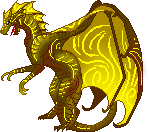
Heartwoodian/Evylonian Bronze
Classification: usually bipedal western/wyvern. Location: abroad in Evylon.
Heartwoodian Bronzes, also called Evylonian Bronzes, are a small race of dragons descended from progenitors that came from interbreeding between Silvers, Greens, and a small number of Golds. Though they never grow very large, they are brightly metallic with stark markings in lighter colors, and uniquely stand upon their hind legs like raptors. They have large, flight-capable wings and an assortment of frills that may often seem too large for their bodies. They have broad, heavily plated features and blunt muzzles, with slender horns.
The Bronzes are exceptionally noble in spirit; many adhere themselves to strict moral codes, and clans of these dragons will chase and oust any that break them. They ally themselves with Halgians and hold the same anti-dark views as the Empire; more Bronzes live there than their homeland of Driakkion.
Typically, these bronze-colored dragons are gifted with a peculiar cold lightning element, and rarely metal manipulation. Bronzes are quick on their feet, though their wings often hamper them when running on the ground; they are agile fliers, and are often dominant in an aerial battle.

Heartwoodian/Evylonian Copper
Classification: large western. Location: abroad in Evylon.
Often rivaling Golds for size, Heartwoodian - or Evylonian - Coppers are descended from Red and Gold pairings that evolved into their own breed over many years. They are muscular and well-built, with beautiful metallic scales that range across a spectrum of rust, copper, and green colors that may be scored with markings in yellows, greens, oranges, blacks, and other hues. They have thick protective plating along their backs, shoulders, thighs and necks, sometimes extending to their face and down their tails. They are often described as sharper-featured than either of their progenitors, and may have extra spikes, frills, and horns as well.
Most Heartwoodian Coppers ally themselves with good races, and are fast friends with Halgians, who they often choose as riders. They are supremely arrogant and narcissistic almost to the point of rivaling Silvers, thinking their scales more beautiful than any others. Many are also quick to anger, and often act upon it.
They are gifted with magic in fire, and rarely light energies. The scales and plates of a Copper are very thick, and resistant to scarring, chipping, or scratching.
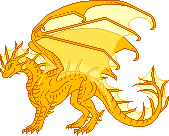
Heartwoodian/Evylonian Gold
Classification: western. Location: abroad in Evylon.
The Heartwoodian Gold, or Evylonian Gold, is a western dragon with bright, metallic golden scales. They are large and slender, with eye color ranging from yellow to green to a deep blue. Frills flank their faces, run down their necks, and fan their tails; their wings have some of the largest wingspan of all the Heartwoodian dragons, most of which are horse-sized or little larger. The web can range from the gold of their scales to a dazzling white, as can their horns and claws. While markings of other colors are very rare, lighter golds, yellows, and creams are common, as are a speckling of whites and a small amount of silvers. Darker gold markings are uncommon, but not so rare as to be unseen.
Thought to be the most noble of all Evylonian dragon breeds, the Golds hold themselves in very high esteem. They seek to protect the weaker races of Evylon, and can be found in small family groups all across the Realm. Many are friendly towards other dragon races - save Blacks - and have befriended elves, halflings, and dwarves to the point where they may be found in many non-dragon cities. They are most common as dragons who have taken riders in the Empire of Halgia.
These Golds are dragons of light and fire, and are able to utilize those elements to their advantage in myriad ways. Their scales are diamond-hard, and they are all but immune to light-based attacks.

Heartwoodian/Evylonian Green
Classification: wyvern. Location: abroad in Evylon.
The Heartwoodian Green, or Evylonian Green, is an almost-awkwardly built wyvern with emerald scales, large frills and odd proportions. A small breed of wyvern with a birdlike face and long, slender wings, Greens are often considered a 'primitive' dragon race physically, still at the whims of the Realm's chaotic evolution. Their fangs are snakelike and retractable, and often have two venomous points per fang. In coloration, they are not often completely green - many have exotic markings, and can range from dull yellow to a viridescent hue so dark it's almost black.
Most Greens are slow-witted, quick to anger and very territorial. They detest other dragons - Heartwoodian and not - and stay strictly within their own clans and tribes. Inter-tribe conflict is very common, and the leading cause of a Green's death is often the fault of another Green.
Unlike most other Evylonian dragons, Greens are not fast or strong; they are ungainly both in the air and on the ground, and cannot fly for great distances. However, their venom is immensely powerful and can be physically debilitating and even fatal depending on the dose delivered. They may also utilize an assortment of elemental magics, though it's rare for any individual Green to acquire mastery in any.
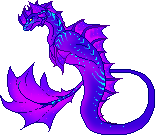
Heartwoodian/Evylonian Indigo
Classification: sea serpent. Location: abroad in Evylon.
The Heartwoodian Indigo, or Evylonian Indigo (also sometimes referred to as the Elven Sea Serpent) is a long-bodied sea serpent colored in shades of deep blues, purples and greens, with varying markings of all three colors. They do not have limbs of any kind, or flippers - but their tails are equipped with large finned frills, and they have similar structures down their backs, flanking their faces, and on their chests. The head and chest fins are uniquely shaped, triangular flares with three to four spines that can appear as lines of cartilage or full, hornlike bone depending on the individual. These fins and frills are completely mobile, and can be raised, lowered, flared or flattened at will. Indigos are much larger than traditional sea serpents, but are also much rarer.
Though not numerous, Evylonian Indigos are often found in free-roaming pods of up to five individuals in the oceans of their Realm. They dwell in both warm and cold waters, but are found most commonly surrounding the Driakkion coast. Though they are amicable to other sea creatures, they have an intense dislike of other sea serpents, leviathans, or oceanic dragons of any kind. Intruders that they take as a threat they will mob and kill without remorse.
All Indigos have the ability to breathe both underwater and above it, utilizing hidden gills and fully-functional lungs. They can exist above the water for short periods of time, though their bulk and lack of limbs makes it difficult to move overland. All have an affinity for the element of water, and some may harness both ice and earth magics in smaller degrees.
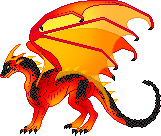
Heartwoodian/Evylonian Red
Classification: western. Location: abroad in Evylon.
The Heartwoodian Red, or Evylonian Red, is a large western dragon with broad wings and thick scales. While the majority of their coloration are variations of scarlet, all have pebble-like, rounded black scales covering portions of their faces, necks, backs, tails and legs. Individuals may have more or less of these pitch-black, coal-like scales and the texture of these, rough or smooth, differs per dragon. Black, silver or golden horns sprout from the skull and spines often line the back all the way down to the tail, though other spikes may be found. Manes and beards are very uncommon, but may also be possible in older individuals. Orange, yellow, black, silver and maroon markings and gradients are all very common, with lighter colors being found on the undersides and in the wing webbing. On average, females are slightly larger than most males.
A cunning and greedy race, Reds are often feared as ruthless marauders, hunting for sport and pillaging for hoards of treasure. They dwell in volcanic regions, relishing in the heat of their homes, and utterly detesting the cold. Most collect in tribes or clans led by a Queen, or - more rarely - an old and powerful Patriarch. Most Reds believe that males are ill-fit to lead, and may reject a male patriarch should he be young and inexperienced. They do not get along with most other dragons, and infighting/civil war in their clans is common.
Evylonian Reds are masters of fire. They are all but immune to flames and heat, but are weak against ice, water, and cold of any kind. Most can breathe fire from hatchlinghood, and many more can manipulate their element in various other ways with training. Other elements are all but absent, though lightning is a rare addition.

Heartwoodian/Evylonian Silver
Classification: wyvern and (rarely) western. Location: abroad in Evylon.
The Heartwoodian Silver, or Evylonian Silver, is a beautiful silver dragon with either western or wyvern qualities. Their scales are highly metallic, sometimes mirror-like in reflective quality, and are kept at a high polish. These dragons have plated armor on their brows, shoulders and thighs, as well as down their necks and backs and have frills that frame sharply-beaked muzzles. A swath of close-set, ridged spikes run from the middle of their forehead down to their tail, ending in a sharp spade or blade; while these spikes cannot be raised or lowered, the frills on either side of their heads can. White markings are very common, as are blue, purple, and a sparse amount of black.
Unlike most of Evylon's other dragon breeds, Silvers ally themselves very specific with races of good alignment, and will often refuse outright to deal with those who stray even a little from the Light. They dwell in great numbers in the Empire of Halgia, and are known to be vain and narcissistic due to their famed beauty. Many will hold some animosity towards Golds, as the Golds are more revered in Halgian culture, though this almost never comes to blows. Elsewhere, they are just as arrogant, though do not hold the vast numbers or take as many riders as they do in Halgia.
Due to their thick, heavy, and relatively slick plated scales, Silvers have above-average physical defense and are gifted with exceptional stamina. Magically, they have lightning and electrical abilities, including minor weather manipulation and storm control. Very few are found to have an affinity for light, like the Golds, but this is quite rare.
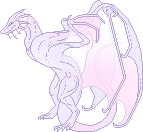
Heartwoodian/Evylonian White
Classification: wyvern. Location: abroad in Evylon.
The Heartwoodian White, also called the Evylonian White or Frostdrake, is a snowy white wyvern found in the northernmost mountains of Evylon. Whites are long and slender wyverns with two sets of wings - one main set, white-webbed and touched with either creamy or rosy hues; and a smaller pair just beneath the main wing arms. These snowy dragons have narrow faces with slender muzzles, frills extending from the chin to connect to the length of its main horns, web stretched taught and thin; teeth are commonly exposed, indicating a diet of fish.
These dragons are known to be ruthless and cunning, their clans taking joy in terrorizing both sapient and non-sapient creatures for sport. Many delight in using their frosty breath whenever possible, and have been known to coat entire forests in ice. While clans are no longer seen amid the Whites outside of Driakkion, many will choose a lifelong mate and stake out territory in the arctic north where other dragons do not roam.
Evylonian Whites are immune from the cold, and have been known to hibernate, all but frozen, in the coldest winter months. They control ice and may breathe both cold air and a cone of frost, though flash-freezing light and heatless blue fire have also been reported. All Whites are very vulnerable to fire, and cannot withstand high temperatures. As such, they do not travel towards warmer climates at all.
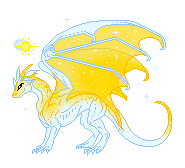
Lost Dragon: Celestial
Classification: very rare dragons infused with the light abilities of the cosmos. Location: abroad.
Created by the gods themselves, Celestials are born with the light-infused energy of the cosmos and have a unique connection to the sun, moon, skies and stars. They were crafted with essence of the Light Realm and are considered to be creatures of great beauty, found in any variant shape from western to cavewyrm. Often times they are pale beasts clad in shades of whites, golds, pinks, creams, and yellows - although there is a wide spectrum of appearances with any number of markings possible. Many are considered to be physical manifestations of the sun and stars themselves and as such markings reflecting galaxies, stars, and heavenly bodies are not uncommon. Some may possess forms of luminescence and can have scales that appear to glow.
Formed by the gods from the energy leftover from the creation of the dragon royals, Celestials are second in power only to the royalbloods themselves and their Cosmic cousins. Very powerful beings, their abilities typically center around the stars and celestial bodies of the Realm they’re currently in; they do not appear to be tied to any Realm in particular and may freely use this energy source wherever it is available. Most are innately gifted with light and fire magic, and may become master healers and illusionists, though with their power any number of elements and abilities are possible. Nearly all are gifted with some form of the Sight, although the exact nature of this gift and the extent to which it is used vary widely from dragon to dragon. Dark magic is all but unheard of in a Celestial dragon.
Nearly all of the original Celestials were killed in the Celestial Wars long ago, and were once thought to be completely extinct. Those that did survive are either immensely ancient, or have descended from the original creations of the gods.
Celestial dragons are limited store species; please do not make one unless bought. Thank you!
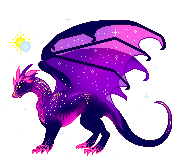
Lost Dragon: Cosmic
Classification: very rare dragons infused with the dark abilities of the cosmos. Location: abroad.
Created by the gods themselves, Cosmics are born with the dark-infused energy of the cosmos and have a unique connection to the sun, moon, skies and stars. They were crafted with essence of the Dark Realm and are considered to be creatures of great beauty, found in any variant shape from western to cavewyrm. Oftentimes, they are dark beasts clad in scales of blacks, purples, pinks, and indigos - although there is a wide spectrum of appearances with any number of markings possible. Many are considered to be physical manifestations of the cosmos itself, and as such markings reflecting galaxies, stars, and heavenly bodies are not uncommon. Some may possess forms of luminescence and can have scales that appear to glow, though this is not as common as their Celestial cousins.
Formed by the gods from the energy leftover from the creation of the dragon royals, Cosmics are second in power only to the royalbloods themselves. Very powerful beings, their abilities typically center around the stars and celestial bodies of the Realm they’re currently in. They do not appear to be tied to any Realm in particular and may freely use this energy source wherever it is available. Most are innately gifted with the element of darkness, and can become great shadowwalkers and dark mages, though with their power any number of elements and abilities are possible. Many are gifted with some form of the Sight, although the exact nature of this gift and the extent to which it is used vary widely from dragon to dragon and have become rarer as time wears on. True light magic in any strength is very uncommon in a Cosmic dragon, and is generally considered quite weak.
Nearly all of the original Cosmics were killed in the Celestial Wars long ago, and were once thought to be completely extinct. Those that did survive are either immensely ancient, or have descended from the original creations of the gods.
Cosmic dragons are limited store species; please do not make one unless bought. Thank you!

Lost Dragon: Lunar
Classification: rare dragons aligned with the power of the moon. Location: abroad.
A subvariant of Cosmics and Celestials, these heavenly dragons possess a powerful and unique connection to the moon. The majority of Lunars are found with cool colors in blues, silvers, greys, and blacks, although their individual looks vary just as broadly as they do. Lunar dragons may be found in any variant body type, though westerns and easterns are most common. Those with bioluminescent markings glow brightest under the light of a full moon, though their colors may seem somewhat dimmed in full sunlight. Most are often nocturnal, though they do not suffer from the same curse as Circadians if they break this cycle. They can sense the current phase of the moon or moons in any Realm, even in broad daylight and can tell the time of night even under the cloudiest of skies.
These dragons draw their strength from the moon or moons and are tied to their phases. They are weakest during the day and are strongest under a full moon, with their powers waxing and waning with the lunar cycles. Unusually, it is known that the phase of a moon - rather than the number of moons present in a Realm - control a Lunar's power over all. While they are not tied to any particular Realm and may use the moons' energies in any Realm that has one or more, they are drawn to sources of celestial magic and often seek out places where these energies are strongest, sometimes moving through Realms when moons are due to become their fullest. Though not as powerful as their Celestial and Cosmic cousins, they are still capable dragons with unique abilities and tend to be gifted in the elements of darkness. However, their abilities are varied and a wide range of magic and element use is seen within them.
Though they were spared the worst during the Celestial Wars by sheer chance, they are still considered very rare. Despite this, they are believed to be the most common of the Lost Dragon subspecies.
Lunar dragons are limited store species; please do not make one unless bought. Thank you!

Lost Dragon: Solar
Classification: rare dragons aligned with the power of the sun. Location: abroad.
A subvariant of Cosmics and Celestials, these heavenly dragons possess a powerful and unique connection to the sun. The majority of Solars are found with warm colors in golds, creams, whites, reds, bright pinks and purples, although their individual looks vary just as broadly as they do. Markings depicting the sun and stars are not uncommon. Many seem to glow under the bright daylight and they can sense the hour/position of the sun even in complete darkness, or if the sun or suns are covered in thick clouds.
These dragons draw their strength from the sun or suns in any particular Realm and are tied to their rising and falling. They are weakest during the night, and are at the strongest during high noon. While they are not tied to any particular Realm and may use the sun’s energies in any Realm that has one, they are drawn to sources of celestial magic and often seek out places where these energies are highest. Though not as powerful as their Celestial and Cosmic cousins, they are still capable dragons with unique abilities and tend to be gifted in the elements of light and fire. However, their abilities are varied and a wide range of magic and element use is seen within them.Though they were spared the worst during the Celestial Wars by sheer chance, they are still considered very rare. Despite this, they are believed to be the second most common of the Lost Dragon subspecies after their Lunar cousins.
Solar dragons are limited store species; please do not make one unless bought. Thank you!
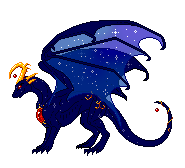
Lost Dragon: Void
Classification: Very rare dragons infused with energy of the Void. Location: Stroen'na.
During the great magestrom that created Stroen’na, a number of Cosmic, Celestial, Solar, and Lunar dragon eggs were sealed away to protect them from the storm’s terrible energy. These eggs were carried away into the Void where they remained for several decades, safely tucked away in deep hibernation. Eventually, they found their way back into the Realms where they hatched from eggs blacker than night speckled with markings like stars. However, the hatchlings within were altered by the mysterious energies of the Void, and developed a strong connection to it.
They are normally smaller, dark dragons whose hides may be any shade ranging from black to deep blues and purples with any number of markings, some resembling the stars and other heavenly bodies. Their exact colors and markings vary greatly, but all have a crystal embedded in their chests for all to see. This crystal blazes with light and energy and are rumored to be glimpses into the soul of the Void itself. Each crystal is a different color and tied to the lifeforce of the dragon it’s on, often corresponding to the color of their reiatsu. Other gems found on or around them, as well as their eyes, are the same color.
As a result of their time spent in the Void, they all have become connected to it in ways not even they can understand. The crystals bound to their chests carry the memories of not only the dragons themselves, but their Lost Dragon ancestors and every Void that has ever died as well. This grants them great insight into the past and the experience of ages despite their relative youth as a species. As such, they may be sought out by those who seek the wisdom of the past or those hungry for information about the Lost Dragons and their history. They may dabble in other forms of magic, but seem to be most adept at the dark arts over any other.
Due to being a relatively new species, their abilities are largely unknown and the true extent of the Void’s influence remains to be seen. As of now, none are older than 700 years of age.
Void dragons are limited store species; please do not make one unless bought. Thank you!
